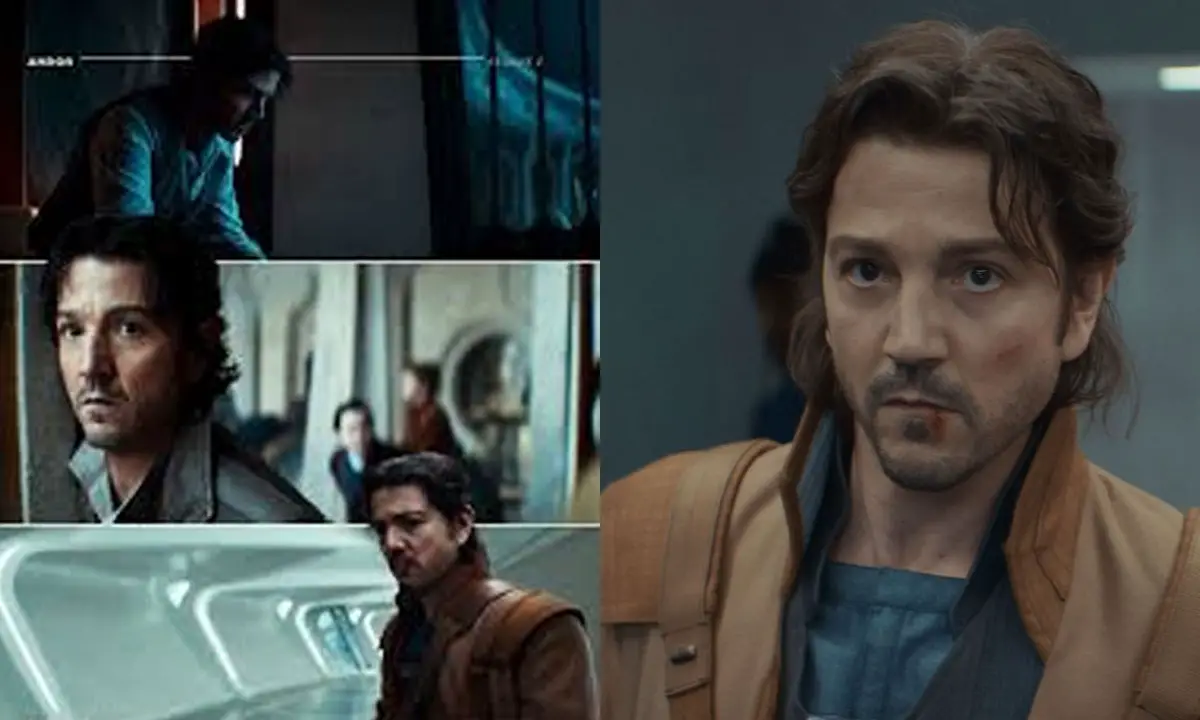The Andor Season 2 finale delivers a heartfelt twist as Bix Caleen raises Cassian’s child, enriching Rogue One’s legacy. Explore fan reactions, character fates, and why Season 3 isn’t happening in this 2000-word in-depth recap.
As the curtain falls on Andor with its gripping Season 2 finale, the Star Wars prequel series has left fans both deeply moved and yearning for more. The finale, which aired on May 13, 2025, offers emotional closure while enriching the narrative groundwork of Rogue One: A Star Wars Story. One of the most poignant moments of the concluding episode comes in the form of a quiet, heartfelt revelation: Bix Caleen, a long-suffering ally of Cassian Andor, is seen raising his child on the tranquil planet Mina-Rau. With this emotional twist, the series affirms its reputation as a mature, character-driven tale that digs deep into the emotional costs of rebellion.
As fans dissect the ending and reflect on the journey of Cassian and his companions, it’s clear that Andor has redefined what a Star Wars story can be. It has taken familiar galactic conflict and recentered it around the people living in the shadow of the Empire—the mechanics, smugglers, spies, and senators whose lives ripple through the saga’s broader events. Now, with confirmation that Season 2 will be the series’ final installment, we look back at the climactic ending, the fate of key characters, and what makes Andor a standout entry in the Star Wars canon.
Read also: Andor Season 2 Episode 9 Ending Explained
The Quiet Bombshell: Bix’s Child with Cassian
The most talked-about moment in the Season 2 finale is the closing scene on Mina-Rau. After an intense journey that spanned planets, power struggles, and personal sacrifices, the series offers a breath of warmth and tenderness. Bix Caleen, played by Adria Arjona, is seen in golden light, walking through fields of grain with a baby in her arms. It is subtly but powerfully implied that this child is hers with Cassian Andor, portrayed by Diego Luna.
The scene is devoid of dialogue. Instead, it lets the visual speak volumes. Bix smiles faintly, her eyes scanning the horizon as she gently rocks the baby. It’s a moment of peace and hope—something all too rare in a story defined by war and loss. The significance of the scene lies not only in its emotional payoff but in what it adds to Cassian’s legacy. As showrunner Tony Gilroy eloquently put it, “It’s just one more thing he’s sacrificing that he doesn’t even know.”
Cassian dies in Rogue One, unaware of the life he helped create. Yet through his death, he ensures a better galaxy for the next generation. Bix raising their child symbolizes that his sacrifice was not in vain—it bore the promise of a future. For fans who have followed Bix’s suffering under the Empire, seeing her safe and nurturing a new life is a powerful emotional payoff.
Humanizing the Rebellion: Character Fates That Resonate
What makes Andor distinct from other Star Wars entries is its refusal to romanticize rebellion. It focuses instead on the cost, chaos, and contradictions of resistance. The Season 2 finale doesn’t just wrap up Cassian’s arc; it ties together the fates of several key players in ways that echo the complexities of real-world revolution.
- Dedra Meero (Denise Gough): The former ISB officer who began the series as a ruthless enforcer of Imperial law ends up imprisoned by the very system she served. Her downfall is ironic and fitting, showcasing the Empire’s indiscriminate cruelty—even to its own. Her fate is a chilling reminder that authoritarian regimes devour their own in pursuit of power.
- Kleya Marki (Elizabeth Dulau): As Luthen Rael’s right hand, Kleya remains one of the most enigmatic characters. In the finale, she survives the fallout from Luthen’s more dangerous maneuvers and emerges with renewed clarity about the rebellion’s purpose. Her final appearance shows her stepping into a larger leadership role—quietly determined, eyes burning with resolve.
- Mon Mothma (Genevieve O’Reilly): The senator continues her political dance on Yavin, navigating treacherous waters to support the fledgling Rebel Alliance. The finale shows her orchestrating secret funding movements and coordinating cells across systems. Though her presence is mostly political, it’s no less pivotal. Her arc lays the foundation for her leadership in the Rebel Alliance as seen in the original trilogy.
Each of these characters shows a different side of resistance—from the quiet strategists to the fanatical enforcers, from the tortured to the hopeful. In doing so, Andor avoids black-and-white morality and instead offers shades of gray, anchored by deeply human motivations.
A Fanbase Deeply Moved: Online Reaction and Emotional Fallout
Unsurprisingly, social media exploded after the finale. On Reddit, Twitter (X), and Star Wars fan forums, users shared their emotional reactions, theories, and deep dives into character arcs. The revelation of Bix raising Cassian’s child was met with widespread praise for its emotional nuance and narrative significance.
Some fans drew parallels between Bix’s final scene and the thematic weight of Rogue One’s ending. Cassian and Jyn Erso died to light the spark of rebellion, and here we see one of those sparks manifest in the form of a child—literal hope for the future.
Reddit user @StarPilot89 wrote, “It was a beautiful way to say goodbye to Cassian. He never got to know his child, but we as viewers know his legacy lives on. That’s Star Wars storytelling at its best.”
Another user, @LightsaberLore, commented, “I never expected to cry over a mechanic from Ferrix walking through a field. And yet, here I am.”
Andor’s Journey: A Grounded Star Wars Masterpiece
The story of Andor began with a character many viewers first encountered in Rogue One—a competent, cold, yet loyal rebel operative. But in the series, Cassian becomes more than just a soldier. Season 1 introduces him as a man in search of family, belonging, and purpose.
Season 1 Recap:
Set five years before Rogue One, Season 1 begins with Cassian searching for his sister on Morlana One. A deadly encounter with two corporate security officers turns him into a wanted man, forcing him to return to Ferrix. There, we meet Bix, his fiercely independent friend, and Maarva, the woman who raised him.
The turning point comes when Cassian is recruited by Luthen Rael to participate in a heist on Aldhani. The mission succeeds but leads to devastating consequences, including increased Imperial crackdowns. Cassian’s capture on Narkina 5 and the subsequent prison escape expose the sheer horror of the Empire’s industrialized oppression.
Meanwhile, Mon Mothma balances her double life as a senator and covert supporter of rebellion. Her subplot adds political depth, showing the dangers of resisting from within the system. Season 1 ends with Maarva’s death and a powerful funeral scene that erupts into a riot. Cassian rescues Bix and commits to the rebellion.
The post-credits scene ties it all together: prisoners from Narkina 5 were unknowingly helping build the Death Star, the very weapon that Cassian will help destroy in Rogue One.
Season 2: Escalation, Loss, and Legacy
Season 2 raises the stakes. Cassian becomes a full-time operative, running missions that edge closer to Rogue One’s timeline. Luthen’s network begins to fracture under the weight of secrecy and sacrifice. New alliances form, old bonds break, and the cost of war grows heavier.
One of the central threads is Cassian’s deepening relationship with Bix. Though they are often separated by missions and circumstance, their bond remains a tether to his humanity. Her capture and torture in Season 1 left fans fearing the worst, and her limited appearances in Season 2 added to the tension.
Her final scene with the child reframes everything that came before. It is not just a personal revelation—it is a thematic statement. The rebellion is not only about destroying the Death Star. It’s about preserving the possibility of life, love, and family.
The Show’s End and the Absence of Season 3
While some fans hoped for a third season, showrunner Tony Gilroy made it clear early on that the series would be limited to two seasons. Originally planned as a five-season arc, the structure was condensed due to the complexity and cost of production.
Gilroy stated in interviews, “We had to be realistic. The scale of the show, the scheduling challenges, and the age of our actors meant we had to pivot. Two seasons gave us the framework to tell a complete story that leads directly into Rogue One.”
Indeed, the final moments of Season 2 show Cassian preparing for a meeting with Tivik on the Ring of Kafrene, directly mirroring the opening scene of Rogue One. This seamless transition reinforces the storytelling cohesion and allows Andor to end on a narratively satisfying note.
FAQ: Everything You Need to Know About Andor
How many episodes are there in Andor?
Andor consists of two seasons with 12 episodes each, totaling 24 episodes. Season 1 premiered on September 21, 2022, and Season 2 concluded on May 13, 2025.
Is Andor connected to Rogue One?
Yes, Andor is a direct prequel to Rogue One: A Star Wars Story. It chronicles Cassian’s transformation from a directionless fugitive to a committed rebel agent. The series ends just before the events of Rogue One begin.
Why did Andor end after two seasons?
Though initially envisioned as a five-season series, logistical issues, high production demands, and the need to align with the timeline of Rogue One led to a condensed two-season run.
Who are the main cast members of Season 2?
Season 2 stars Diego Luna as Cassian Andor, Adria Arjona as Bix Caleen, Stellan Skarsgård as Luthen Rael, Genevieve O’Reilly as Mon Mothma, and Denise Gough as Dedra Meero. Supporting roles include Elizabeth Dulau as Kleya and Faye Marsay as Vel Sartha.
Will we see more of these characters elsewhere in Star Wars?
There’s no official confirmation, but given Star Wars’ expansive storytelling methods—including animation, novels, and spin-offs—it’s possible that characters like Bix or Kleya may appear in future projects.
Read also: Andor Season 2: Release Date, Cast, Plot & Everything You Need to Know
Conclusion: A Farewell That Echoes
Andor’s final season delivers a masterclass in storytelling, bridging the intimate and the epic, the personal and the political. It leaves behind not only the memory of Cassian Andor’s bravery but also the ripples of his choices—felt through a child, a grieving lover, a hardened spy, and a determined senator.
In a galaxy defined by heroes and villains, Andor reminds us that the true engine of change lies with ordinary people who choose to resist. As Bix cradles her child beneath the sunlit sky of Mina-Rau, the legacy of rebellion lives on—not in blasters and battleships, but in the quiet moments of love that follow the storm.

